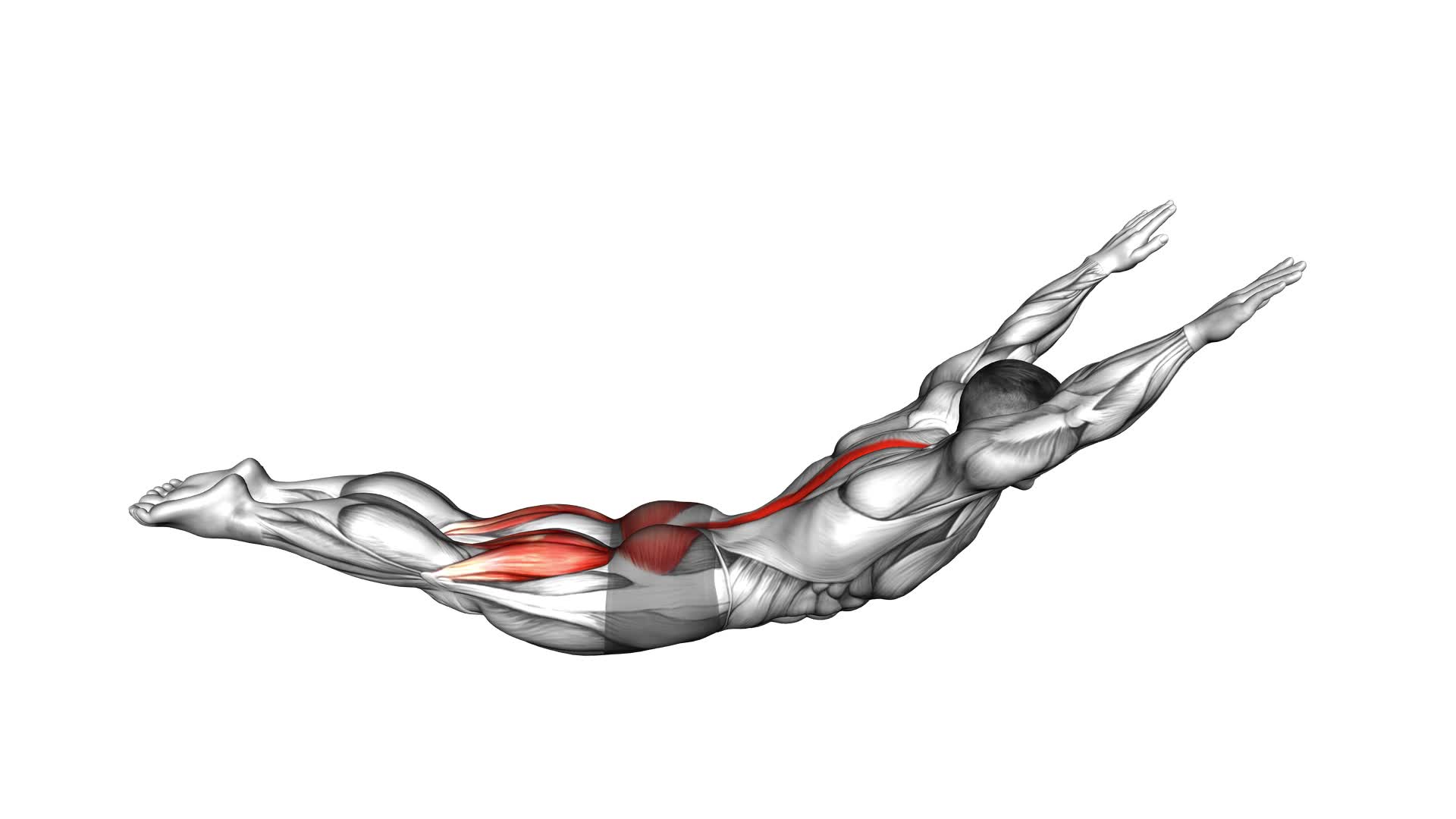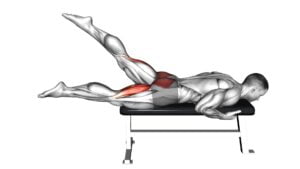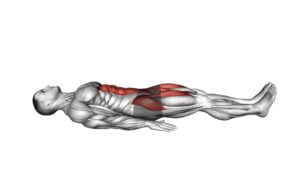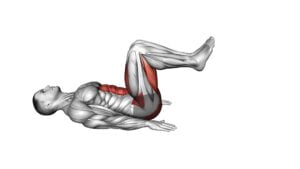Lying Back Extension (male) – Video Exercise Guide & Tips

Looking to strengthen your back muscles? Check out this video exercise guide for the lying back extension specifically designed for men.
Watch This Exercise Video
In just a few minutes, you'll learn the proper form and technique to maximize the benefits of this exercise. We'll also provide you with tips to avoid common mistakes and ways to increase intensity.
Whether you're a beginner or an experienced gym-goer, this guide will help you take your back workout to the next level.
Key Takeaways
- Lying back extension strengthens the lower back muscles.
- There are various variations of lying back extension that target different muscle groups.
- Proper form and technique, such as maintaining a neutral spine position and engaging the core muscles, are crucial during lying back extension.
- Incorrect form during lying back extension can lead to injuries and potential dangers, such as excessive strain on the lower back and muscle strains.
Benefits of Lying Back Extension for Men
To maximize your workout routine, incorporate the lying back extension exercise for men, which can help strengthen your lower back muscles. The lying back extension is a versatile exercise that offers various variations for men to target different muscle groups and challenge themselves.
One variation for the lying back extension is the weighted version. To perform this exercise, you can either hold a weight plate against your chest or use a weighted vest. This variation adds resistance, making your lower back muscles work harder to lift your upper body off the ground.
Another variation is the stability ball back extension. By lying face down on a stability ball, you engage your core muscles while performing the back extension movement. This variation not only strengthens your lower back but also improves your balance and stability.
To incorporate the lying back extension into a full-body workout routine for men, you can include it as part of your back day or as an accessory exercise after your main lifts. It's important to start with lighter weights or bodyweight and gradually increase the intensity as you become more comfortable and stronger. Remember to maintain proper form throughout the exercise to avoid any injuries.
Proper Form and Technique for Lying Back Extension
Maintain a neutral spine position throughout the lying back extension exercise to ensure proper form and technique. This is essential for maximizing the benefits of this exercise and preventing injuries. To maintain a neutral spine, keep your head aligned with your spine and avoid arching or rounding your back. Engage your core muscles to stabilize your spine throughout the movement.
In addition to maintaining proper spinal alignment, it's important to focus on proper breathing techniques during the lying back extension exercise. Breathe in as you lower your upper body towards the ground and exhale as you lift it back up. This coordinated breathing pattern helps to engage your core muscles and optimize the effectiveness of the exercise.
While the lying back extension is a great exercise for strengthening your lower back and glutes, there are alternative exercises that can target these muscles as well. Some alternative exercises include the Superman exercise, bird dog, and hip extensions. These exercises can provide similar benefits while offering variations in movement and muscle activation.
By maintaining a neutral spine position, focusing on proper breathing techniques, and exploring alternative exercises, you can ensure that you're performing the lying back extension exercise with proper form and technique. This will help you avoid common mistakes and maximize the benefits of this exercise.
Now, let's discuss some common mistakes to avoid during lying back extension.
Common Mistakes to Avoid During Lying Back Extension
When performing the lying back extension, it's important to be aware of common mistakes that can put you at risk. Incorrect form can lead to potential dangers, such as straining your back or causing injury.
Overextending the back or neglecting to engage your core muscles can also hinder the effectiveness of the exercise.
Stay mindful of these points to ensure a safe and effective lying back extension workout.
Incorrect Form Dangers
During the lying back extension, it's crucial for you to avoid common mistakes by not allowing your hips to lift up off the bench. Maintaining proper form is essential for preventing injuries and avoiding the dangers of incorrect form.
When your hips lift off the bench, it puts excessive strain on your lower back, which can lead to muscle strains, herniated discs, or even spinal misalignment. By keeping your hips firmly planted on the bench, you ensure that the targeted muscles, such as the erector spinae and glutes, are properly engaged without putting undue stress on your lower back. This helps to prevent injuries and allows you to effectively strengthen your back muscles.
Now, let's move on to the next section about overextending the back.
Overextending the Back
To avoid overextending your back during the lying back extension, ensure that you keep your spine in a neutral position throughout the exercise. Overextending the back can put excessive stress on the spine and increase the risk of injury. When you overextend, you arch your back too much, which can strain the muscles and ligaments in the area. To prevent this, focus on maintaining a slight curve in your lower back while performing the exercise. This will help you engage the targeted muscles without compromising the integrity of your spine.
If you find it difficult to maintain a neutral spine, you can try modifying the exercise by performing a supported back extension on an exercise ball or using a foam roller. These alternatives can help reduce the risk of overextension and provide a safer workout experience.
Now let's discuss the importance of not neglecting core engagement.
Neglecting Core Engagement
To avoid neglecting core engagement during the lying back extension exercise, it's important to maintain a strong and active core throughout the movement. Core activation is crucial for stability and proper form during this exercise.
Neglecting core engagement can lead to muscle imbalances and increase the risk of injury. By actively engaging your core, you can prevent excessive arching of the lower back and ensure that the movement is controlled and effective.
To activate your core, focus on drawing your belly button towards your spine and squeezing your abdominal muscles. This will help to stabilize your spine and maintain proper alignment throughout the exercise.
Tips to Increase Intensity and Challenge in Lying Back Extension
To increase intensity and challenge in the lying back extension exercise, there are a few tips you can follow.
First, try advanced modification variations such as performing the exercise on an unstable surface or incorporating rotational movements.
Additionally, you can increase the weight or resistance by using a weighted vest or holding a dumbbell or medicine ball.
These modifications will help you push your limits and continue progressing in your back extension routine.
Advanced Modification Variations
How can you increase the intensity and challenge in the lying back extension exercise?
If you're looking for advanced modifications to take this exercise to the next level and increase difficulty, there are a few options to consider.
One option is to add resistance by holding a weight plate against your chest or by using resistance bands. This will engage your muscles even more and make the exercise more challenging.
Another option is to perform the exercise on an unstable surface, such as a stability ball or a BOSU ball. This will require your core muscles to work harder to stabilize your body, increasing the intensity of the exercise.
Lastly, you can also try performing the exercise with a slower tempo, focusing on the eccentric phase of the movement. This will further engage your muscles and increase the difficulty of the exercise.
Increasing Weight and Resistance
To increase the intensity and challenge in the lying back extension exercise, you can incorporate additional weight and resistance.
By increasing the resistance, you can maximize the results of this exercise and target your back muscles even more effectively.
One way to do this is by holding a weight plate against your chest while performing the exercise. Start with a lighter weight and gradually increase it as you become stronger.
Another option is to use resistance bands. Attach a band to a sturdy anchor point and loop it around your shoulders or hold it in your hands while performing the exercise. The resistance provided by the bands will add an extra challenge to the movement, helping you build strength and achieve better results.
Remember to maintain proper form and control throughout the exercise to avoid injury and get the most out of your workout.
Precautions and Modifications for Lying Back Extension
Before attempting the lying back extension exercise, be aware of certain precautions and modifications that can help ensure your safety and maximize the effectiveness of the movement.
- Listen to your body: Pay attention to any discomfort or pain during the exercise. If you experience any sharp or intense pain, stop immediately and consult a professional.
- Start with a lighter weight: If you're new to this exercise, begin with a lighter weight to allow your body to adapt and prevent strain or injury.
- Maintain proper form: Keep your core engaged and your back straight throughout the movement. Avoid excessive arching or rounding of the spine to protect your lower back.
- Use a mat or cushion: Placing a mat or cushion under your hips can provide additional support and cushioning, especially if you have a sensitive lower back.
By following these precautions and modifications, you can reduce the risk of injury and make the most out of your lying back extension exercise.
Remember to consult with a fitness professional if you have any concerns or specific physical conditions.
Stay safe and enjoy your workout!
Sample Lying Back Extension Workout Routine for Men
To begin your lying back extension workout routine for men, incorporate a variety of exercises that target your lower back muscles. Start with the basic lying back extension exercise, where you lie face down on a mat with your hands behind your head and lift your upper body off the ground. This exercise helps to strengthen and tone your lower back muscles.
After mastering the basic exercise, you can add variations to your routine to make it more challenging. One variation is the Superman exercise, where you lie face down with your arms extended in front of you and lift your arms and legs off the ground simultaneously. This exercise not only targets your lower back muscles but also engages your core for added benefits.
Another variation is the Swiss ball back extension, where you position yourself face down on a Swiss ball and perform the back extension movement. This exercise adds instability, which further engages your core muscles.
Incorporating these lying back extension variations into your workout routine for men won't only strengthen your lower back muscles but also improve your core strength and stability. Remember to always maintain proper form and engage your core throughout the exercises for optimal results.
Frequently Asked Questions
How Many Sets and Repetitions Should I Do When Performing the Lying Back Extension Exercise?
When performing the lying back extension exercise, it's important to know how many sets and repetitions to do.
By focusing on the current question, you can determine the ideal number for your workout.
Additionally, understanding the benefits of this exercise for core strength and common mistakes to avoid will help you maximize your results.
Stay informed and knowledgeable to make the most of your lying back extension routine.
Can I Perform the Lying Back Extension Exercise if I Have a History of Lower Back Pain?
If you have a history of lower back pain, it's important to be cautious when performing the lying back extension exercise. There are alternative exercises that can provide lower back pain relief, such as the pelvic tilt, bird dog, or cat-camel stretch.
Additionally, it's crucial to follow certain tips to prevent lower back pain during exercise, such as maintaining proper form, avoiding overexertion, and listening to your body's signals.
Consulting a healthcare professional is recommended before starting any exercise program.
Is It Necessary to Use Any Additional Equipment or Weights While Doing the Lying Back Extension Exercise?
To maximize the benefits of the lying back extension exercise, using additional equipment or weights isn't necessary. This exercise primarily targets your lower back muscles, helping to strengthen and improve flexibility.
Can I Incorporate the Lying Back Extension Exercise Into a Full-Body Workout Routine?
Incorporating the lying back extension exercise into your full-body workout routine offers numerous benefits. It helps strengthen your lower back, glutes, and hamstrings, improving posture and reducing the risk of back pain.
You can modify the exercise by using additional weights or equipment to increase resistance. Variations include performing the exercise on an exercise ball or with a resistance band.
Are There Any Alternative Exercises That Target the Same Muscle Groups as the Lying Back Extension Exercise?
If you're looking for alternative exercises that target the same muscle groups as the lying back extension, there are a few options you can consider.
However, it's important to note that the lying back extension offers unique benefits compared to other exercises. It specifically targets the lower back muscles and helps improve spinal alignment.
To ensure proper form and technique when performing the lying back extension, focus on maintaining a neutral spine and engaging your core muscles.
Conclusion
In conclusion, the lying back extension is a beneficial exercise for men, as it targets the lower back muscles and helps improve posture and spinal stability. By maintaining proper form and technique, avoiding common mistakes, and implementing tips to increase intensity, men can effectively challenge their muscles and see progress.
However, it's important to exercise caution and make modifications if necessary, to prevent any potential injuries. Incorporating the lying back extension into a regular workout routine can contribute to overall strength and fitness for men.

Author
Years ago, the spark of my life’s passion ignited in my mind the moment I stepped into the local gym for the first time. The inaugural bead of perspiration, the initial endeavor, the very first surge of endorphins, and a sense of pride that washed over me post-workout marked the beginning of my deep-seated interest in strength sports, fitness, and sports nutrition. This very curiosity blossomed rapidly into a profound fascination, propelling me to earn a Master’s degree in Physical Education from the Academy of Physical Education in Krakow, followed by a Sports Manager diploma from the Jagiellonian University. My journey of growth led me to gain more specialized qualifications, such as being a certified personal trainer with a focus on sports dietetics, a lifeguard, and an instructor for wellness and corrective gymnastics. Theoretical knowledge paired seamlessly with practical experience, reinforcing my belief that the transformation of individuals under my guidance was also a reflection of my personal growth. This belief holds true even today. Each day, I strive to push the boundaries and explore new realms. These realms gently elevate me to greater heights. The unique combination of passion for my field and the continuous quest for growth fuels my drive to break new ground.



